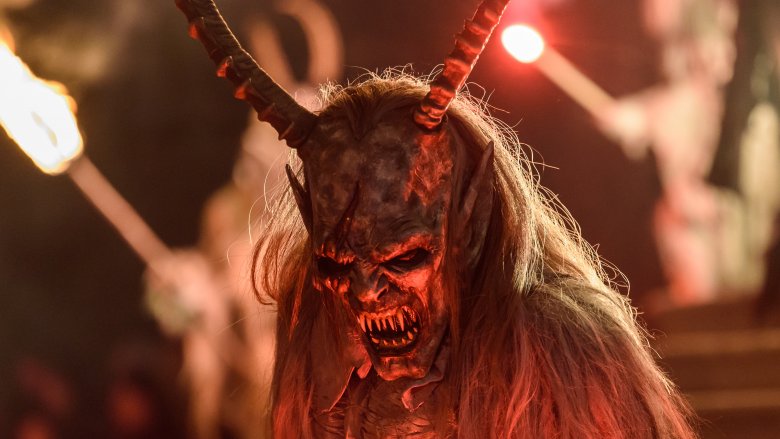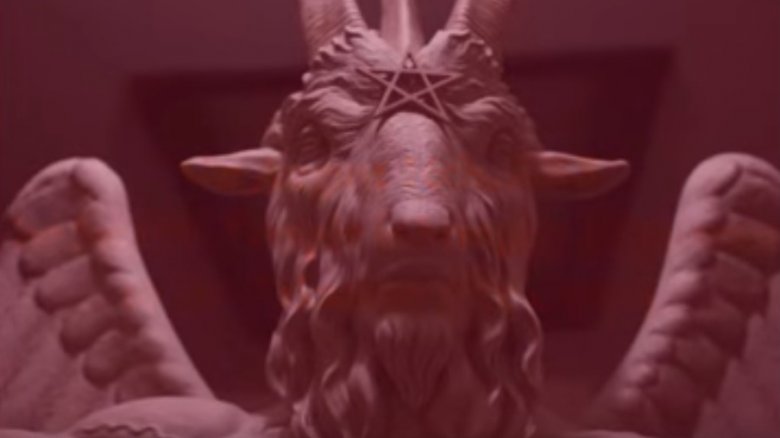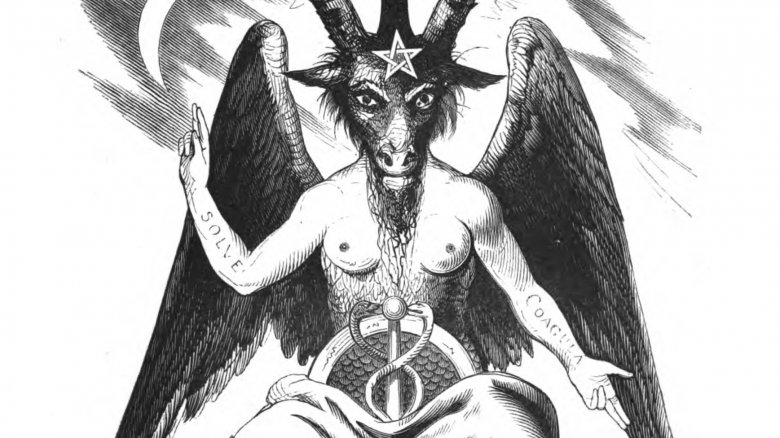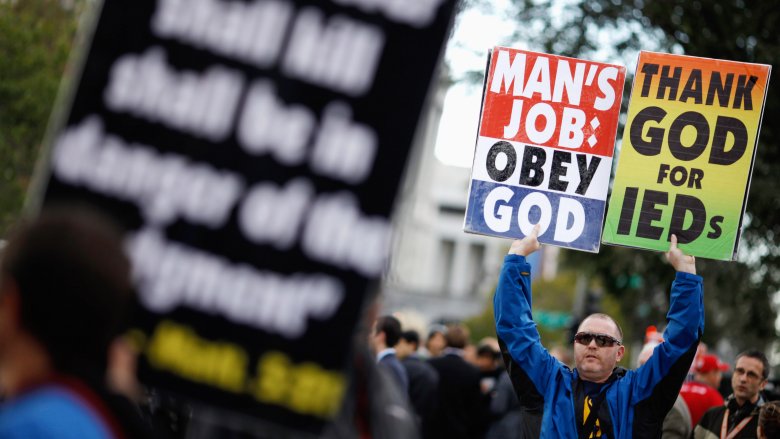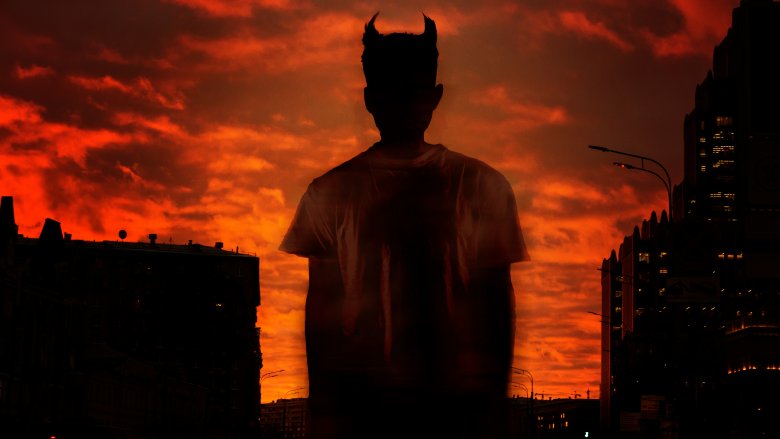The Untold Truth Of The Satanic Temple
There are a few things in the world that will always be polarizing, and nothing divides people into "us" and "them" quite like politics and religion. People spend a lot of time arguing about who has the only actual real god, but what about the people rooting for Satan?
Everyone's heard of the Satanic Temple, and the name conjures up images of a group of people dressing in black, performing weird rituals and a bit of animal sacrifice, and trying to bring about the end of the world. Or raise the Antichrist. Or do whatever else it is that truly evil people do. Create new reality TV shows? Troll the good guys on social media? Put candy corn on pizza? (It's the mundane evil that's most dangerous, after all.)
But peek at their mission statement, and it seems they're something else entirely. They do stand against a lot ... like Westboro Baptist Church, corporal punishment in schools, and pseudoscientific claims in physical and mental health care. That ... doesn't sound so dark after all, does it? What's really up with these guys? Here's the untold truth of the Satanic Temple.
No, they don't actually worship the Christian Satan
It's the biggest misconception about the Satanic Temple: that they worship Satan. Instead, Satan is a sort of metaphor — in their mythos, he symbolizes a refusal to blindly follow authority just because. He stands for rational inquiry, defending the rights of the self in the face of oppression, and a refusal to accept superstition and the supernatural on faith alone.
It's heavy stuff, and they also say the best way to think of their Satan is to think of him as the version Milton was writing about in Paradise Lost.
Even so, they do have a set of rules they all strive to follow. Instead of Ten Commandments, there are Seven Tenets. They start with this one: "One should strive to act with compassion and empathy towards all creatures in accordance with reason." They go on to say members should value justice over laws and institutions, that a person's body is theirs and no one else's, all freedoms — including the freedom to offend — should be respected. Also, beliefs should be based in science, people are fallible, and "compassion, wisdom, and justice should always prevail."
Not what you expected?
That Baphomet statue
One of the most high-profile activities the Satanic Temple has been involved with is the installation of the horned, winged, goat-man Baphomet in public spaces, almost always alongside Christian imagery. In August 2018, they unveiled the statue at the Arkansas State Capitol.
It was the centerpiece of a rally (not a permanent installation) meant to bring awareness to the hypocrisy the Temple — and other groups like the Arkansas Society of Freethinkers — saw in the enforcement of the First Amendment. Just a few months prior, a monument to the Ten Commandments had been installed at the Capitol. (The previous monument was destroyed by a man proclaiming to be the rider on the white horse from Revelations.)
The Baphomet statue isn't necessarily meant to be a protest against the Christian monument, just meant as a reminder that if one religious group is allowed to be represented on state grounds, then all religious groups should be. And they'd been through this before: They protested a Ten Commandments monument in Oklahoma in 2014, and the Christian contingent lost. According to Pacific Standard, The Satanic Temple's causes often go hand in hand with lawsuits and motions filed by the American Civil Liberties Union, and if they keep winning court cases, it could be precedent-setting when it comes to redefining the First Amendment.
Who is Baphomet, anyway?
The goat-man depicted in the statue is the symbol of the Satanic Temple, but it's not Satan, it's Baphomet. The BBC looked at where this demonic-looking creature came from, and they traced Baphomet's first appearance to only 1100 — positively recent as far as religious figures go.
The very first time he cropped up was in the trials of the Knights Templar. French chroniclers say the knights were accused of worshipping Baphomet, a name some believe was a sort of mistranslation of "Mahomet," or the prophet Muhammad. Is it? That's one of those mysteries that will probably never be solved.
Baphomet wasn't given his goat-like form until much later — 1856, to be precise, when occultist Eliphas Levi sketched him for the book Transcendental Magic: Its Doctrine and Ritual. He pictured the creature as it's still used today: as opposites existing in one creature. He's male and female, tattooed with the Latin for both "separate" and "join together," both animal and human, and pointing both up and down in a gesture that means "as above, so below." The caduceus on his stomach is an ancient Greek symbol usually carried by messengers and referring to negotiation, and his middle horn is a torch representing knowledge.
The Satanic Temple did made some changes to Levi's Baphomet for their statue. The goat-man originally sported breasts to signify the feminine, which they removed to make him a little more publicly presentable. (The male-female aspect is portrayed in the children alongside him.)
The Church of Satan isn't a fan
The Church of Satan absolutely shouldn't be confused with the Satanic Temple — they're two entirely separate entities, and the adherents aren't really fans of each other.
The Church of Satan is the one founded by Anton LaVey, and while they also use Baphomet and also champion personal freedoms, their Nine Satanic Statements include things like vengeance, indulgence, and championing the sins because, essentially, they make you feel awesome. They've also condemned The Satanic Temple as "a fake religion," full of people who "are not Satanists" and who "do not have shared 'deeply held beliefs' and are unrelated to Satanism." They've even gone as far as writing and releasing their own (dismissive) FAQ, calling the Satanic Temple basically a big hoax.
Lucien Greaves, the head of the Satanic Temple, has hit back. He said the original vision for the group was a small-scale operation more focused on a cause than either a hierarchy or being "'true' Satanists" practicing rituals. Whatever the truth, don't mistake one for the other.
Their campaign against pseudotherapy
In 2013, Satanic Temple leader Lucien Greaves sat down for an interview with Vice, and talked about — among other things — one of the biggest crusades the organization has embarked on. It was against a particular subset of therapy and therapists, part that encourages people to remember repressed memories. It's called "dissociative amnesia," a plot device for countless movies. It's basically when someone suffers something so traumatic they lose memory of it.
It also, Greaves says, "breeds conspiracy theory and literally indoctrinates clients into false beliefs." His beef is twofold: First, repressed memories have been used as evidence to convict people of crimes they didn't commit at the same time it's used as evidence of things like alien abduction and past lives.
He says it's also largely these memories that are used to generate false beliefs about the threat of Satanic rituals — rituals and cults Greaves has researched and never found concrete evidence for. He grew up during an era dubbed "the Satanic Panic," when games like Dungeons & Dragons were condemned for being gateways to violent Satanism. He found there were no actual cults but plenty of mysteriously rediscovered memories, and he wants to stop that type of what he calls "pseudotherapy" in hopes of replacing it with education about the techniques that real cults use to groom and recruit people.
Accusations they don't practice what they preach
The Satanic Temple isn't without internal conflict, though, if a Medium piece from former member Jex Blackmore is any indication. Blackmore wrote the piece in August 2018, just a few months after leaving the Temple and her position as spokesperson.
Blackmore claimed that what was going on inside the temple wasn't necessarily in line with their Seven Tenets, writing, "As one of the few visible and prominent female voices in TST, I endured countless threats, harassment, and violations." She says that on the surface, her dismissal from her spokesperson position (which came a month before she left the group completely) came because of a performance piece where she issued threats against "the president," while she says it was actually "asserting a paternalistic need to put a woman in her place, gain control, and undermine her autonomous power."
Blackmore went on to claim that the leaders of the Satanic Temple repeatedly refused to implement policies of gender, racial, and sexual diversity, and that some exploited their positions for their own gains and had pushed already marginalized members to the sides. She also says there's a ton of money being wasted, accuses the temple of mismanaging funds, and condemns them for their lack of a board of directors and public accountability. Has the temple gotten too big for its britches? At least Jex thinks so.
Extending the cloven hoof of friendship
In 2015, the world was stunned by the events of yet another terrorist attack, this time unfolding across the city streets of Paris. Fear was at an all-time high, and the Minneapolis chapter of the Satanic Temple posted a simple message on their Facebook page that got a ton of attention. It read:
"If there is anyone in the Minneapolis area who is Muslim and afraid to leave their home out of fear for some kind of backlash, don't hesitate to reach out to us. We would be glad to escort you where you need to go without advertising our presence — just big dudes walking you where you need to be."
The message was withdrawn not long after, but according to Esquire's interview with Satanic Temple leaders, it was pulled because they didn't "want to be offering a service that we can't follow through on." While they called the Paris attacks "horrific acts of religious extremism," they also went on to point out how important it was to restart the conversation about religious freedom. They reminded everyone that "Muslim" and "terrorist" are not the same thing, and called knee-jerk reactions of oppression "every bit of the problem and never the solution."
Pink Masses, the Westboro Baptist Church, and the adopt-a-highway program
While the Satanic Temple isn't doing any traditionally "Satanic" rituals or animal sacrifice, they are using their Satanism to get attention in some extreme ways. In 2013, they took on Westboro Baptist Church when they performed a so-called Pink Mass over the grave of WBC founder Fred Phelps' mother. The purpose of the mass was to turn her spirit gay, and according to what Lucien Greaves told Vice, the idea was that if Phelps and his church wanted to go around spewing their anti-gay rhetoric and hate speech, they'd better be equal opportunity about it because his mother was now gay, too.
They added that the idea came after WBC announced it would protest at the funerals of the Boston Bombing victims, and the Satanic Temple decided a celebration of same-sex love at the gravesite was a great way to join in. Bizarrely, there was another thing on the agenda: raise awareness for their attempts at adopting a highway in New York City.
As if the story couldn't get more weird, Vice also reported that the local Mississippi police department was considering filing charges against the participants, including malicious mischief, trespassing, and indecent exposure.
Twitter, the Alt-Right and unrest among the chapters
It's a long, complicated saga, but here are the basics. In early 2018, Lucien Greaves and the Satanic Temple set their sights on Twitter after Corey Feldman retweeted a random person asking for someone to burn down Satanic Temple headquarters. The group filed a complaint, but their own Twitter accounts were suspended and nothing came of the threats made against them. They felt this was religious discrimination and decided to seek legal counsel.
Here's where a ton of Satanic Temple members had a problem. Greaves hired Marc Randazza. If he sounds familiar, it's because he's represented neo-Nazi groups, Alex Jones, and some other high-profile names of the alt-right.
Greaves went into damage control mode, while chapter heads spoke out against the decision. Two chapters left the temple over Randazza's appointment. TST Los Angeles withdrew and renamed itself the Satanic Collective, while the London chapter became Satanic Temple International. Greaves continued to stand by the appointment, telling Jezebel, "TST and its mission are my life. ... I'm fighting for TST, I'm fighting for Satanists. Satanists come in all varieties, from any race, religious upbringing, gender, and orientation."
Thou shalt not steal
The Satanic Temple doesn't bring chaos and hatred everywhere it goes, and they've actually been at the heart of a wonderful community project that encouraged a surprising bit of togetherness.
In 2017, their San Jose chapter joined in some holiday merrymaking when they set up a Christmas tree in the local Christmas in the Park celebration. SF Gate says their tree was one of more than 600 (assembled with hopes of breaking a world record), and it wasn't long before someone stole their Baphomet tree topper. The group declined to have it treated as a hate crime and said the support they got from the community was outstanding. Numerous other groups offered to replace their tree topper for them in the true spirit of Christmas, and Satanic Temple members — led by Jedidiah Schadenfreude — proved themselves the bigger people.
"We know who we are, we know how we're perceived," he said. "All we can do is just be good members of the community and hope to change that stigma that we have."
Campaigning for the good of almost all
So, if there are no rites and rituals, no crazy sacrifices, and no worshiping of Satan, what are they campaigning for?
The Satanic Temple has a pretty long and somewhat surprising list of campaigns they've begun championing since their inception. In addition to crusading for true religious equality and a separation of church and state, they've also started the Protect Children Project. It's essentially a program that encourages schoolchildren to reach out and report rights violations, like the use of corporal punishment or denial of bathroom access. The Satanic Temple then acts as advocates for them.
They also have an after-school program called After School Satan, a group that protests therapists who pressure clients into recalling false memories, and a campaign that strives to cement women's rights not only to abortion, but to accurate medical information about procedures. Turns out, some of the things they're campaigning against are more terrifying than any Black Mass.

